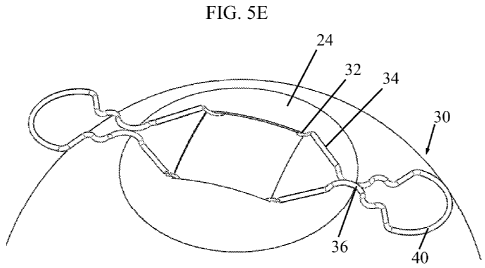Note: Claims are shown in the official language in which they were submitted.
11
CLAIMS
What is claimed is:
1. An iris retractor (10, 30, 50, 150, 170, 190, 200) characterised by:
a plurality of iris grabbing hooks (12, 32, 52, 152, 172, 192, 202) disposed
or
formed at a distal end of slender elements (14, 34, 54, 154, 174, 194, 204);
and
a proximal handle (20, 40, 60, 176, 196, 206) at a proximal end of said
slender
elements (14, 34, 54, 154, 174, 194, 204), said slender elements (14, 34, 54,
154, 174,
194, 204) resiliently moving between retracted and expanded positions by
manipulation
of said slender elements (14, 34, 54, 154, 174, 194, 204), wherein in the
retracted
position, said hooks (12, 32, 52, 152, 172, 192, 202) are close to one another
and said
slender elements (14, 34, 54, 154, 174, 194, 204) are close to one another,
and wherein in
the expanded position, said hooks (12, 32, 52, 152, 172, 192, 202) are
separate and spaced
apart from each other and distal portions of said slender elements (14, 34,
54, 154, 174,
194, 204) are separate and spaced apart from each other.
2. The iris retractor (10, 30, 170) according to claim 1, further comprising a
retaining
element (16, 36, 181) that retains said slender elements (14, 34, 174) in the
retracted
position until said slender elements (14, 34, 174) are moved to the expanded
position.
3. The iris retractor (10) according to claim 2, wherein a portion of said
retaining
element (16) is formed with a groove (19), and in the expanded position, said
handle (20)
is received in said groove (19).
4. The iris retractor (30) according to claim 2, wherein said retaining
element (36)
comprises a groove (38) formed in one of said slender elements (34) for
receiving therein
the other slender element (34).
5. The iris retractor (50) according to claim 1, wherein said slender elements
(54) are
pivotally attached to one another at a pivot (56).
6. The iris retractor (10, 30, 50, 150, 170, 190, 200) according to claim 1,
wherein
each of said hooks comprises a U-shaped hook (70) with a short distal
extension (72)
formed at a tip of said slender element (14, 34, 54, 154, 174, 194, 204).
7. The iris retractor (10, 30, 50, 150, 170, 190, 200) according to claim 1,
wherein a
tip of said slender element extends from a proximal sleeve (74).
8. The iris retractor (10, 30, 50, 150, 170, 190, 200) according to claim 1,
wherein
said hook (70) is retractable into said slender element.
9. The iris retractor (170) according to claim 1, wherein said hooks (172)
curve back
onto said slender elements (174).
12
10. The iris retractor (170) according to claim 2, wherein said retaining
element (181)
is pivotally connected to a toggle lever (1820, which is pivotally connected
at a pivot
(183) on a distal end of a handle (184), said toggle lever (182) pivotable to
move said
retaining element (181) to clamp around said slender elements (174) to retain
said slender
elements (174) in the retracted position, and said toggle lever (182) is also
pivotable to
move said retaining element (181) to release said slender elements (174) to
expand to the
expanded position.
11. The iris retractor (190) according to claim 1, wherein said handle (196)
is
sufficiently resilient to flatten into an oblong shape when squeezed.
12. The iris retractor (200) according to claim 1, wherein said handle
comprises two
scissor handles (206) spring loaded by a biasing device (208).
13. A method for retraction of an iris comprising:
providing an iris retractor (10, 30, 50, 150, 170, 190, 200) that comprises a
plurality of hooks (12, 32, 52, 152, 172, 192, 202) disposed or formed at a
distal end of
slender elements (14, 34, 54, 154, 174, 194, 204), and a proximal handle at a
proximal
end of said slender elements (14, 34, 54, 154, 174, 194, 204), said slender
elements (14,
34, 54, 154, 174, 194, 204) resiliently moving between retracted and expanded
positions
by manipulation of said slender elements (14, 34, 54, 154, 174, 194, 204),
wherein in the
retracted position, said hooks (12, 32, 52, 152, 172, 192, 202) are close to
one another and
said slender elements (14, 34, 54, 154, 174, 194, 204) are close to one
another, and
wherein in the expanded position, said hooks (12, 32, 52, 152, 172, 192, 202)
are separate
and spaced apart from each other and distal portions of said slender elements
(14, 34, 54,
154, 174, 194, 204) are separate and spaced apart from each other;
inserting said slender elements (14, 34, 54, 154, 174, 194, 204) in the
retracted
position through a small incision near a limbus of an eye;
manipulating said slender elements (14, 34, 54, 154, 174, 194, 204) to the
expanded position; and
grasping and retracting a portion of the iris with said hooks (12, 32, 52,
152, 172,
192, 202).
14. The method according to claim 13, wherein the incision for insertion of
said
slender elements (14, 34, 54, 154, 174, 194, 204) is made at a different
position than an
incision for phacoemulsification.
